Art Deco Architecture: Raleigh’s Style in Short Supply
Architecturally speaking, Raleigh is known for its modernist buildings, specifically of the mid-century era. What we have far less of is Art Deco, which was popular in the 1920s to 1940s. This style combined a minimalist and sleek design with use of icons and patterns, sometimes from other cultures.
The Durham Life Insurance Building is easily Raleigh’s most prominent example. It was built in the early 1940s, and expanded a few years later. It was the first Raleigh skyscraper to feature air conditioning.
The Creamery
The Creamery on Glenwood Avenue is often overlooked as an architectural gem. It’s not only an Art Deco beauty, but has significant historical value as well, once being home to Pine State Creamery. Pine State was a dairy supplier for much of the area from the early part of the 20th century until the late 1990s.
Built in 1928 (and expanded in later decades), it was renovated by Clearscapes for commercial use in 1998. The building is now adorned with a churn and milk bottle sculpture, resting atop the tower. Although the churn and milk bottle sculpture didn’t originally exist on the building, it was in the original plans. The sculpture wasn’t included in the late 20s due to budget concerns. The tower sculpture from the 1998 renovation looks great, and was created by my favorite light sculptor, Matt McConnell while working for Clearscapes.
Some could argue this building is more Art Moderne than Art Deco, but I think the tower decidedly places it in the latter category.
The 1925 CP&L truck garage is a unique structure in that it is distinct Art Deco, yet it makes expansive use of glass. This was out of necessity, in order to make the most of natural light. It is also Raleigh’s first curtain wall structure.
SH Kress & Co.
Barely visible in the photo above is the word KRESS, which was the name of a chain of five and dime retail stores across the country. Many of the Kress buildings were extravagant and full of Art Deco flair, such as the one in Asheville.
According to Wake County tax records, the building was built for SH Kress company in 1953. Although Kress stores were known for flair and highly visible decorative elements, it appears Raleigh got a rather vanilla version of the store. The unique window structure and horizontal lines are the subtle features distinguishing this in the style.
1953 was an inopportune time to locate a retail establishment in Downtown Raleigh, or most places in America. Cameron Village had been built a few years before, and downtown was rapidly becoming an unfashionable place to be. This Kress location didn’t last long– it became the Olivia Raney Library in 1961.
The Capital Club
The 1930 Capital Club Building straddles the line between the Art Deco and Classicist styles. It was built in 1930 for the Capital Club, a prominent men’s social organization.
The Capital Club is kind of like an Art Deco sandwich. The base and top levels are in the style, but the midsection is of classical form.
The lower floor is home to the excellent restaurant Capital Club 16. The upper floor remains a ballroom in the Art Deco style.
The 1928 Firestone Garage on West Martin near Berkeley Cafe is another modest example of Art Deco.
It is now home to White Horse Private Transportation.
The Rialto was built in 1942 and is the last of a dying breed: the (near) downtown theater. The interior has  the lighting and stage with a distinctly vintage feel, retaining much of its original Art Deco charm.
Another Building With Swagger: E. B. Bain Water Treatment Plant
Funded in part by public works money and driven by a local enthusiasm for growth, in the 1930s Raleigh built the water treatment plant. It contains a surprising amount of sophistication and detail. The building has been opened up a tiny handful of times for art installations by its current owner, Empire Properties.
Can There Be New Art Deco?
I’m not sure if there is an Art Deco revivalism, or if anything created recently can be called that. But if new construction could be considered in that style, the new Wake County Justice Building comes awfully close:
Do you think the new Wake County building is in the Art Deco style? Are there any other examples in Raleigh of this unique style of building?
If you’re looking to go on an architectural vacation, a visit to Asheville is well worth the trip. It has one of the best preserved and most beautiful collections of Art Deco architecture in the United States.

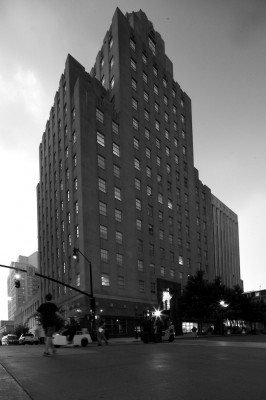
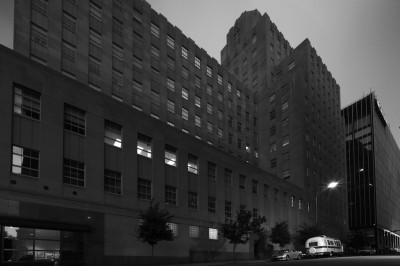
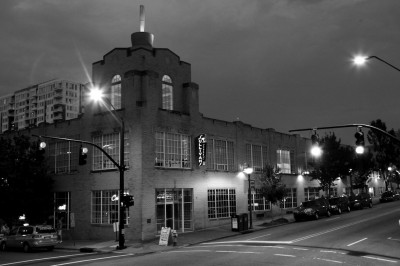
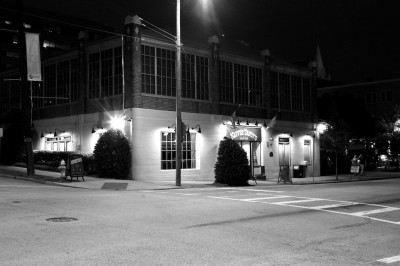

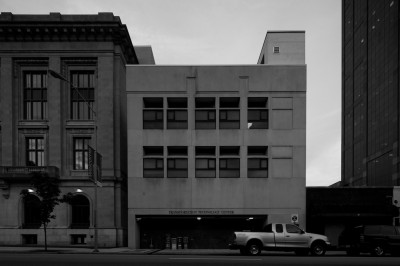
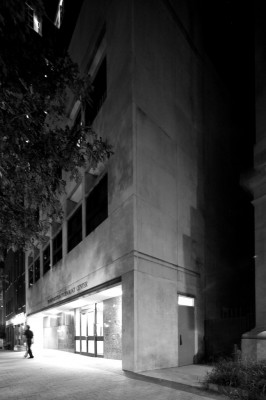
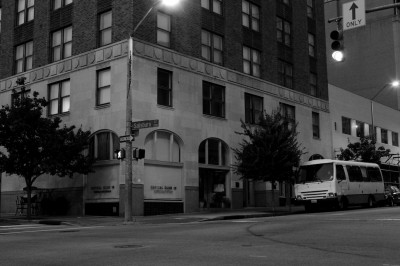
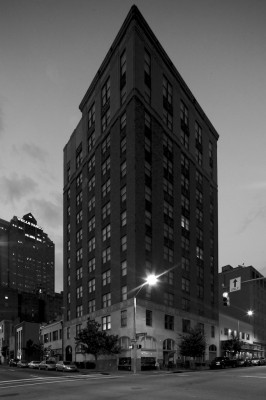
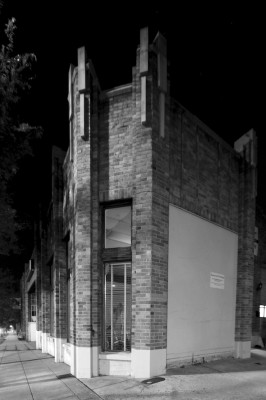
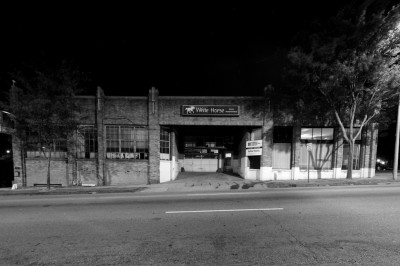
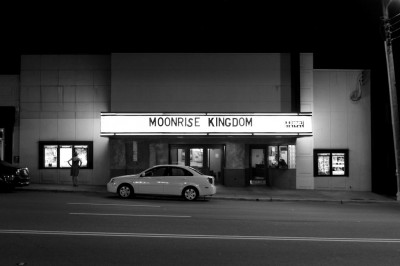


 Sign up for the Newsletter
Sign up for the Newsletter
07/20/2012
Great article. I love art deco and other similar styles (streamline moderne is great too). It’s nice seeing all of Raleigh’s main examples listed together.
Asheville definitely has the state’s best supply of art deco buildings. Durham actually has a few good examples downtown. Winston-Salem has a handful as well.
What those three cities have in common is a large amount of growth from the 1920s to 1940s. Meanwhile, Raleigh had a large growth spurt in the 50s and 60s which is why we have more modernist architecture than those others.
I’m glad the new Wake County building is trying to give a good nod to the art deco style. In my view, it’s probably one of the coolest-looking government buildings around.
07/20/2012
Ditto what Rob said, thank you for the article! I read somewhere there used to be more Art Deco theaters in Raleigh before they were torn down or gutted…
07/21/2012
Holy crap, I had to lookup the address to be sure, but the Rialto is the old Colony Theater, where I spent many a Saturday morning, later weekend afternoons and even later date nights. But the Saturday morning shows were the best, with William Castle gimmicks and a very hot candy counter girl. The owners later (quite the Jewish characters they were) opened the theaters at Crabtree Valley and bought up some other theater properties.
Speaking of Crabtree, have you ever covered Kidd Brewer’s influence on Raleigh? Tho not JW York he was certainly more interesting.
07/21/2012
Holy crap, the Rialto looked a lot better as the Colony. I loved the ladies’ restroom at the Colony, the art deco fixtures, original, I’m sure: round, tarnished mirrors, light fixtures out of a 1930’s movie. In the 1970’s I went there to see Leon Redbone, live on stage. The only time I remember a full house at the Colony (usually the house was about 50 people and a few guys in raincoats). Next to the theater was a bar, a gay bar, I was told. Coming out of the Redbone show my date, who had parked on the street, saw that he had a flat tire. He struggled for about 15 minutes with the tire jack, refusing help from me, when two very nice women came out of the bar, took the lug wrench away from him, and changed the tire in two minutes. Good times.
07/22/2012
The theater was more than full and rockin’ when my older sister took me to see Elvis Presley in “Jailhouse Rock”. It was so full that we sat in the aisle. Kids (older kids) were jumpin’ and jivin’. Since I lived within walking distance, my friends and I spent a lot of Saturdays there. $.50 would get us in the door, and buy us a soda and popcorn. I think that the last movie the wife and I attended, a soda and popcorn was something like $15.00. Granted the boxes/cups are much bigger now, but I think that the popcorn was better then.
07/23/2012
Along with Googie, Art Deco is my favorite style, probably because both of them have been used extensively for imagined futures that never were; but I digress…
I drive by the Wake County building all the time, and I’d never considered it Art Deco, BUT, from that perspective, the vertical features definitely make it seem that way. If they were actually angled in the way this photo makes them seem to be, then definitely.
07/23/2012
I was told the Rialto/Colony was originally built as a grocery store but rationing during the war made that unprofitable and it was converted to a theater. The space immediately adjacent was a lunch counter when it was a grocery store and remained a lunch counter when it became a theater. The space next to that was a series of gay bars, mostly lesbian: the Mouse Trap, 1622, and another name I can’t remember – then it became Churchill’s Cigar Bar. During my high school days, in the 1980’s, the Rialto would often run double features of Hollywood classics and they struggled to get by. The boom in Independent Film hadn’t happened yet. And they had a hot woman working the ticket booth named Marti.
07/24/2012
The Rialto was originally a grocery store. It was a pretty big store for its day. The building was constructed in 1935. It closed in 1941 and opened as the Colony in 1942. The current bar (The Well, at 1620 1/2 Glenwood) was indeed the lunch counter for the grocery (at 1620, now the Rialto). The silver grill exhaust hood was still there while the Stingray was open just behind the bar close to the front door. The bar where Churchill’s is now was the gay bar (called 1622). It was technically a gay bar, but it had a very mixed, neighborhood bar feel. I don’t remember there being another gay bar there after 1622 closed. The owners of CC’s also owned 1622.
07/24/2012
That black vertical spire(?) that sits on the top of the marquee and rises above the building used the have a ton of neon on it and had COLONY spelled out in huge neon letters, vertically, from top to bottom on both sides. The city wouldn’t allow new neon to be installed to say RIALTO due to sign ordinances. I’m not sure if this is still the case, but I would wager that it is.
07/24/2012
The Rialto Theater is listed at 1630 Glenwood Ave in Google Maps. In the 1940 Raleigh city directory there is a listing for an A&P Food Store at the address.1622 Glenwood is the Town and Country shop (women’s wear). 1624 is Teague’s Dry Cleaning. 1626 Hayes Barton Soda Shop. 1628 Franklin’s Pharmacy. 1630-32 Piggly-Wiggly grocery.
07/24/2012
Rialto is at 1620. I worked there for 16 years. It was an A&P until 1941.
07/24/2012
My bad — a typo the Rialto is at 1620 Glenwood, not 1630.
07/24/2012
The dry cleaners was there for a LONG time. I think the soil was very contaminated at that site.
07/24/2012
Wasn’t there a Winn Dixie on one of the Five Points? I thought where the dry cleaning building is there was an old WD.
07/24/2012
The Winn-Dixie was situated about where the Bloomsbury Bistro is with its front parking lot where Rite-Aid and that ugly building on the corner is. It faced the corner of Fairview and Whitaker Mill. Years ago there was supposedly a Piggly-Wiggly about where the BP gas station is. I guess that was before it was at the location that is now NoFo.
07/24/2012
Is there a way to post pictures in the comments here? I just found a picture of the Five Points Winn-Dixie in my files.
07/24/2012
Wesley Hughes: You can use the free image hosting service http://imgur.com. After you upload the image, you will see a section that says “HTML Image (websites & blogs).” Copy that code and you can paste it into the comments here.
07/24/2012
I thought I might have to go that route. I was hoping there was a way to post it inline here, perhaps. Here ya go. Whitaker Mill Rd. is in the foreground, church is behind you.
07/24/2012
07/25/2012
Thanks, Wesley. GNR readers are the best. Now my question is…when the old WD was demolished, were those lovely homes in the neighborhood suddenly overrun with the various forms of life that must have certainly been living in the cracks and crevices of the building? That happened to me once. A nightmare.
07/25/2012
Dang. I sure wish that grocery store was still there! And to think, just across Glenwood, there was a Piggly Wiggly, and just back down Whitaker Mill, there was a Colonial Store.
07/26/2012
There are some great aerial pictures (1940s/1950s) of the Five Points business district on the website of the neighborhood’s Citizens Advisory Council:
http://fivepointscac.org/node/15
08/27/2012
I always thought the new Wake County building was paying tribute to the art deco Firestone/ White Horse building across the street?
10/04/2012
I think a couple decent examples may have been missed. Dont know what to call ot but the brick buildingon the east corner of the block of the old school for the blind (on left when you go under the new skybridge om mcdowell). Also, forgetting the name again, but the building on the south east corner of morgan and fayetteville is special in my view because it is a greek revival government building in the art deco style. The lighting in the front and the statue on the top make it obvious. Worth checking out for sure.
08/23/2016
great job…nice to see a few Deco in Raleigh